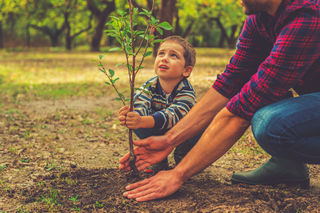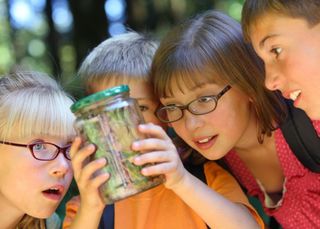Environment
8 Eye-Opening Ways Kids Benefit from Experiences with Nature
Nature-based pedagogy boosts student performance via eight different pathways.
Posted March 18, 2019 Reviewed by Lybi Ma
Having experiences related to nature and incorporating nature-based instruction into kids’ daily school activities promotes better learning via eight distinct pathways, according to a new critical review of current peer-reviewed research. The question-answer format of the paper’s title encapsulates the research question and findings of this systematic review: “Do Experiences With Nature Promote Learning? Converging Evidence of a Cause-and-Effect Relationship.” This critical review was recently published in the journal Frontiers in Psychology.
Ming Kuo of the Department of Natural Resources and Environmental Sciences at the University of Illinois, Urbana-Champaign co-wrote and edited the manuscript of this review with two co-authors: Michael Barnes from the Department of Forest Resources at the University of Minnesota and Catherine Jordan from the UMN’s Department of Pediatrics and the Children & Nature Network in Minneapolis.

"Even small exposures to nature are beneficial. If you're indoors, having a view of your yard as opposed to facing the wall, that makes a difference. At the same time, more is better. That's one of the things that gives us more confidence that we're seeing a real cause-and-effect relationship," Kuo said in a statement. "The bigger the dose of nature we give a person, the bigger the effect we see in them."
Before diving into the details of this systematic review of nature-based learning research, it’s important to note that prior to conducting this critical review of the nature-learning relationship, Kuo et al. were skeptical that empirical evidence would support a hypothesis that nature-based instruction was more effective than traditional instruction (TI).
"The intuition that 'nature is good for children' is widely held, and yet, historically, the evidence for this intuition has been uncompelling, with a distressing number of weak studies and inflated claims," the authors bluntly stated in their paper's introduction. "Now, however, an impressive body of work has accrued and converging lines of evidence paint a convincing picture."

Notably, this systematic analysis is not the result of Kuo and colleagues cherry-picking empirical evidence to corroborate a hypothesis. This critical review of nature-based learning also avoids the “file drawer problem” (Rosenthal, 1979) of burying research that shows null results.
In a statement, Ming Kuo expressed that she was surprised by the findings of this analysis. Apparently, Kuo expected her team's recent review (2019) to result in more questions about a possible nature-learning correlation than cut-and-dried evidence revealing a cause-and-effect relationship. As the authors explain:
“Do experiences with nature—from wilderness backpacking to plants in a preschool, to a wetland lesson on frogs—promote learning? Until recently, claims outstripped evidence on this question. But the field has matured, not only substantiating previously unwarranted claims but deepening our understanding of the cause-and-effect relationship between nature and learning. Hundreds of studies now bear on this question, and converging evidence strongly suggests that experiences of nature boost academic learning, personal development, and environmental stewardship.
The research on personal development and environmental stewardship is compelling although not quantitative. Report after report—from independent observers as well as participants themselves—indicate shifts in perseverance, problem solving, critical thinking, leadership, teamwork, and resilience. Similarly, over fifty studies point to nature playing a key role in the development of pro-environmental behavior, particularly by fostering an emotional connection to nature.”
As mentioned, the critical review of nature-based learning research by Kuo et al. (2019) identified eight distinct pathways through which experiences with nature benefit students. In their full paper, the authors cite multiple peer-reviewed studies under each category. In an attempt to keep this post concise, I've curated and streamlined the authors' full list of cited references under each category by choosing illustrative examples from the critical review:
1. Nature Has Rejuvenating Effects on Attention: Students who were randomly assigned to classrooms with views of greenery perform better on concentration tests than those assigned to purely “built” views or windowless classrooms (Li and Sullivan, 2016).
2. Nature Relieves Stress: Nature has been related to lower levels of both self-reported and physiological measures of stress in children (Bell and Dyment, 2008; Chawla, 2015; Wiens et al., 2016).
3. Contact With Nature (and Animals) Boosts Self-Discipline: The types of self-discipline assessed include delay of gratification (Faber Taylor et al., 2002) and parent ratings of hyperactivity (Flouri et al., 2014), and the types of “nature” include not just “greenness” but contact with horses in animal-assisted learning (Ho et al., 2017).
4. Student Motivation, Enjoyment, and Engagement Are Better in Natural Settings: The positivity of learning in nature seem to ripple outward, as seen in learners’ engagement in subsequent, indoor lessons (Kuo et al., 2018a), ratings of course curriculum, materials, and resources (Benfield et al., 2015) and interest in school in general (Blair, 2009; Becker et al., 2017), as well as lower levels of chronic absenteeism (MacNaughton et al., 2017).
5. Time Outdoors Is Tied to Higher Levels of Physical Activity and Fitness: Importantly, cardiorespiratory fitness is the component of physical fitness most clearly tied to academic performance (Santana et al., 2017). Further, there is some indication greener school grounds can counter children’s trend toward decreasing physical activity as they approach adolescence: in one study, girls with access to more green space and woodlands, and boys with access to ball fields, were more likely to remain physically active as they got older (Pagels et al., 2014).
6. Nature May Boost Learning by Providing a More Supportive Context for Learning: Greener environments may foster learning because they are calmer and quieter, because they foster warmer relationships, and because the combination of “loose parts” and relative autonomy elicits particularly beneficial forms of play.
7. Vegetated Settings Tend to Provide Calmer, Quieter, Safer Contexts for Learning: In greener learning environments, students who previously experienced difficulties in traditional classrooms are better able to remove themselves from conflicts and demonstrate better self-control (Maynard et al., 2013; Ruiz-Gallardo et al., 2013; Swank et al., 2017).
8. Natural Settings Seem to Foster Warmer, More Cooperative Relations: Learning in nature facilitates cooperation and comfort between students and teachers, perhaps by providing a more level playing-field wherein the teacher is seen as a partner in learning (Scott and Colquhoun, 2013).
The latest critical review (Kuo et al., 2019) on the benefits of nature-based pedagogy dovetails with another recent study (Hardiman et al., 2019) by researchers at Johns Hopkins University which found that arts-integrated science learning benefited academic performance in fifth-grade classrooms.
Taken together, the latest pedagogical findings suggest that experiences in nature and making art are a winning combo that boosts academic performance and learning in ways that are currently undervalued and underfunded by education policymakers.
For more, see:
References
Ming Kuo, Michael Barnes, and Catherine Jordan. "Do Experiences With Nature Promote Learning? Converging Evidence of a Cause-and-Effect Relationship." Frontiers in Psychology (First published: February 19, 2019) DOI: 10.3389/fpsyg.2019.00305
Mariale M. Hardiman, Ranjini Mahind John Bull, Deborah T. Carran, and Amy Shelton. "The Effects of Arts-Integrated Instruction on Memory for Science Content." Trends in Neuroscience and Education (First published online: February 7, 2019) DOI: 10.1016/j.tine.2019.02.002




